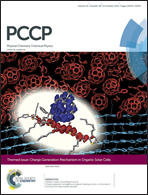Revealing the charge transport mechanism of a photoelectrochemical cell: analysis using A.C. voltage perturbation†
Abstract
In this paper, we have carefully investigated the operation of a photoelectrochemical (PEC) cell configured of PbOx|Fe(CN)6−4/−3|Pt in the accumulation, flat band, depletion, inversion and deep-depletion regions using impedance measurements. The increases in the photocurrent for the different regions differ in their nature: a logarithmic increase in the depletion region, a linear increase in the inversion region along with a linear increase in the dark current and an exponential increase in the photo- and dark current in the deep-depletion region. All these variations are studied in detail to correlate these observations to the charge transfer mechanisms. The characteristics of the impedance spectrum itself can be assigned to the mentioned regions. We have found that the maximum photocurrent of the PEC cell, in the present investigation, can be extracted when the cell is working in the inversion region, while the maximum rate of the increase in photocurrent is found when the junction behaves as an ideal Schottky diode with a single RC element. Systematic experiments are suggested to establish a correlation between the observations obtained from the photocurrent, impedance, conductance, low frequency and high frequency capacitance measurements. It was found that light induced trap states in the semiconductor limit the photocurrent which has a linear dependency on the irradiance. A detailed investigation with A.C. conductivity measurements showed that the trap states actively participate in the current mechanism via a hopping phenomenon with small activation energies of 0.2 and 0.8 meV. The hopping rate increased exponentially with the applied bias under dark and illumination conditions. We also show a new way of finding the potential at which the maximum photocurrent will be extracted from the PEC cell, wherein the hopping via trap states is a dominating charge transfer mechanism. This study will help in pin pointing the key affecting parameters which limit the charge transfer process in the cell.


 Please wait while we load your content...
Please wait while we load your content...